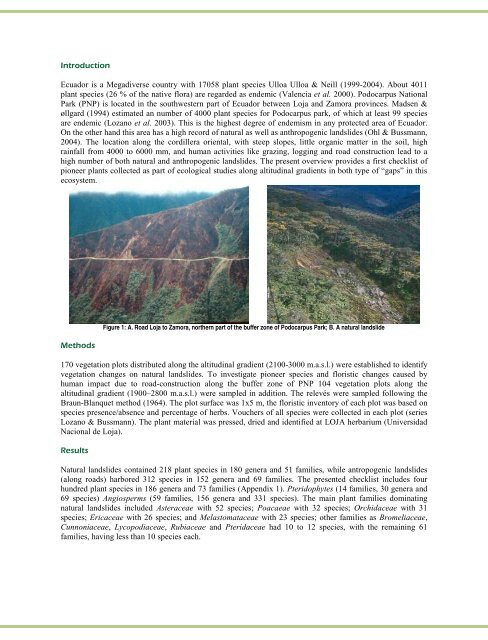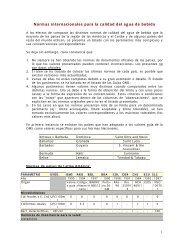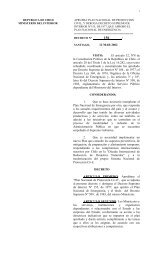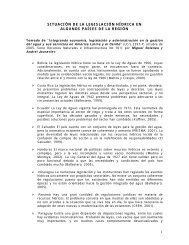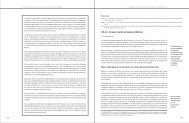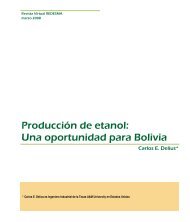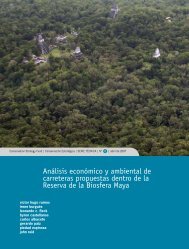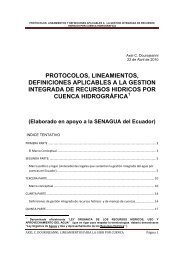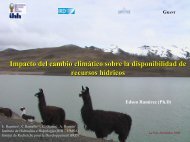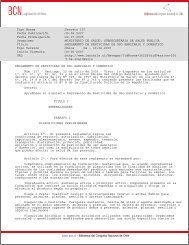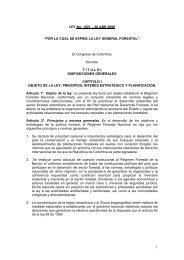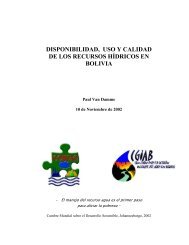A checklist of pioneer plant regeneration on natural and ...
A checklist of pioneer plant regeneration on natural and ...
A checklist of pioneer plant regeneration on natural and ...
You also want an ePaper? Increase the reach of your titles
YUMPU automatically turns print PDFs into web optimized ePapers that Google loves.
Ecuador is a Megadiverse country with 17058 <str<strong>on</strong>g>plant</str<strong>on</strong>g> species Ulloa Ulloa & Neill (1999 -2004). About 4011<br />
<str<strong>on</strong>g>plant</str<strong>on</strong>g> species (26 % <str<strong>on</strong>g>of</str<strong>on</strong>g> the native flora) are regarded as endemic (Valencia et al. 2000). Podocarpus Nati<strong>on</strong>al<br />
Park (PNP) is located in the southwestern part <str<strong>on</strong>g>of</str<strong>on</strong>g> Ecuador between Loja <strong>and</strong> Zamora provinces. Madsen &<br />
øllgard (1994) estimated an number <str<strong>on</strong>g>of</str<strong>on</strong>g> 4000 <str<strong>on</strong>g>plant</str<strong>on</strong>g> species for Podocarpus park, <str<strong>on</strong>g>of</str<strong>on</strong>g> which at least 99 species<br />
are endemic (Lozano et al. 2003). This is the highest degree <str<strong>on</strong>g>of</str<strong>on</strong>g> endemism in any protected area <str<strong>on</strong>g>of</str<strong>on</strong>g> Ecuador.<br />
On the other h<strong>and</strong> this area has a high record <str<strong>on</strong>g>of</str<strong>on</strong>g> <strong>natural</strong> as well as anthropogenic l<strong>and</strong>slides (Ohl & Bussmann,<br />
2004). The locati<strong>on</strong> al<strong>on</strong>g the cordillera oriental, with steep slopes, little organic matter in the soil, high<br />
rainfall from 4000 to 6000 mm, <strong>and</strong> human activities like grazing, logging <strong>and</strong> road c<strong>on</strong>structi<strong>on</strong> lead to a<br />
high number <str<strong>on</strong>g>of</str<strong>on</strong>g> both <strong>natural</strong> <strong>and</strong> anthropogenic l<strong>and</strong>slides. The present overview provides a first <str<strong>on</strong>g>checklist</str<strong>on</strong>g> <str<strong>on</strong>g>of</str<strong>on</strong>g><br />
<str<strong>on</strong>g>pi<strong>on</strong>eer</str<strong>on</strong>g> <str<strong>on</strong>g>plant</str<strong>on</strong>g>s collected as part <str<strong>on</strong>g>of</str<strong>on</strong>g> ecological studies al<strong>on</strong>g altitudinal gradients in both type <str<strong>on</strong>g>of</str<strong>on</strong>g> “gaps” in this<br />
ecosystem.<br />
<br />
Figure 1: A. Road Loja to Zamora, northern part <str<strong>on</strong>g>of</str<strong>on</strong>g> the buffer z<strong>on</strong>e <str<strong>on</strong>g>of</str<strong>on</strong>g> Podocarpus Park; B. A <strong>natural</strong> l<strong>and</strong>slide<br />
170 vegetati<strong>on</strong> plots distributed al<strong>on</strong>g the altitudinal gradient (2100-3000 m.a.s.l.) were established to identify<br />
vegetati<strong>on</strong> changes <strong>on</strong> <strong>natural</strong> l<strong>and</strong>slides. To investigate <str<strong>on</strong>g>pi<strong>on</strong>eer</str<strong>on</strong>g> species <strong>and</strong> floristic changes caused by<br />
human impact due to road-c<strong>on</strong>structi<strong>on</strong> al<strong>on</strong>g the buffer z<strong>on</strong>e <str<strong>on</strong>g>of</str<strong>on</strong>g> PNP 104 vegetati<strong>on</strong> plots al<strong>on</strong>g the<br />
altitudinal gradient (1900–2800 m.a.s.l.) were sampled in additi<strong>on</strong>. The relevés were sampled following the<br />
Braun-Blanquet method (1964). The plot surface was 1x5 m, the floristic inventory <str<strong>on</strong>g>of</str<strong>on</strong>g> each plot was based <strong>on</strong><br />
species presence/absence <strong>and</strong> percentage <str<strong>on</strong>g>of</str<strong>on</strong>g> herbs. Vouchers <str<strong>on</strong>g>of</str<strong>on</strong>g> all species were collected in each plot (series<br />
Lozano & Bussmann). The <str<strong>on</strong>g>plant</str<strong>on</strong>g> material was pressed, dried <strong>and</strong> identified at LOJA herbarium (Universidad<br />
Naci<strong>on</strong>al de Loja).<br />
<br />
Natural l<strong>and</strong>slides c<strong>on</strong>tained 218 <str<strong>on</strong>g>plant</str<strong>on</strong>g> species in 180 genera <strong>and</strong> 51 families, while antropogenic l<strong>and</strong>slides<br />
(al<strong>on</strong>g roads) harbored 312 species in 152 genera <strong>and</strong> 69 families. The presented <str<strong>on</strong>g>checklist</str<strong>on</strong>g> includes four<br />
hundred <str<strong>on</strong>g>plant</str<strong>on</strong>g> species in 186 genera <strong>and</strong> 73 families (Appendix 1). Pteridophytes (14 families, 30 genera <strong>and</strong><br />
69 species) Angiosperms (59 families, 156 genera <strong>and</strong> 331 species). The main p lant families dominating<br />
<strong>natural</strong> l<strong>and</strong>slides included Asteraceae with 52 species; Poacaeae with 32 species; Orchidaceae with 31<br />
species; Ericaceae with 26 species; <strong>and</strong> Melastomataceae with 23 species; other families as Bromeliaceae,<br />
Cunn<strong>on</strong>iaceae, Lycopodiaceae, Rubiaceae <strong>and</strong> Pteridaceae had 10 to 12 species, with the remaining 61<br />
families, having less than 10 species each.


